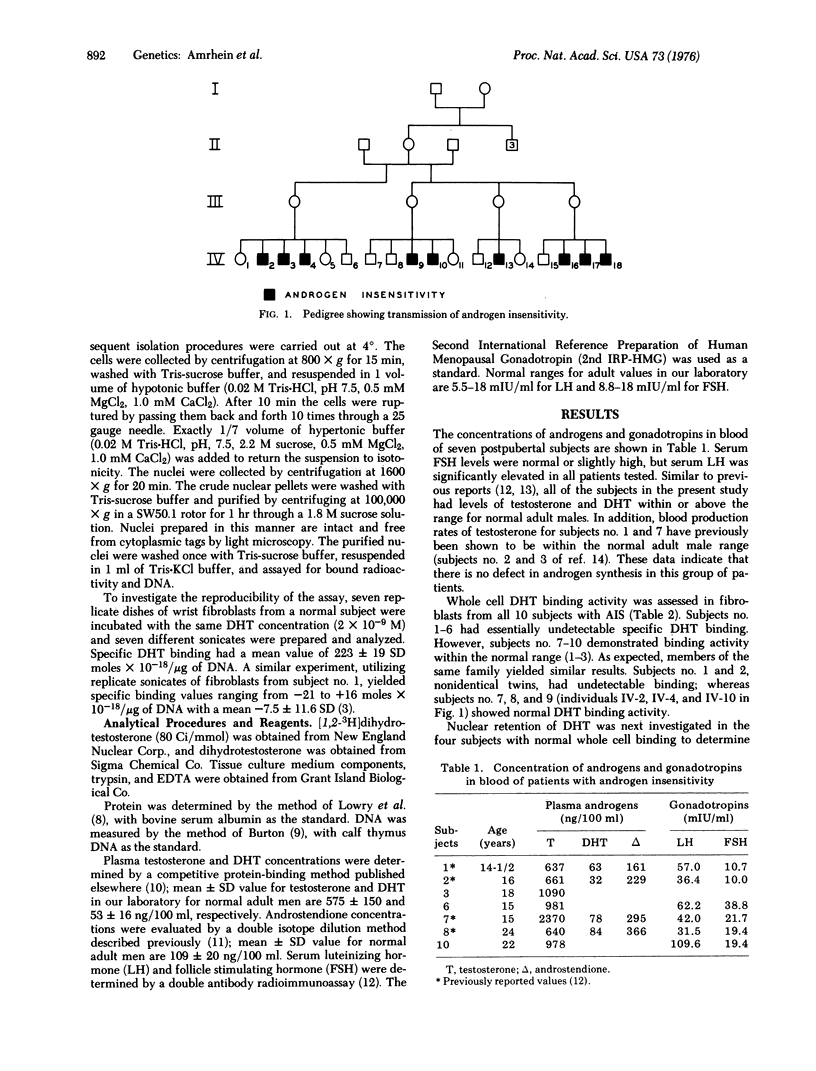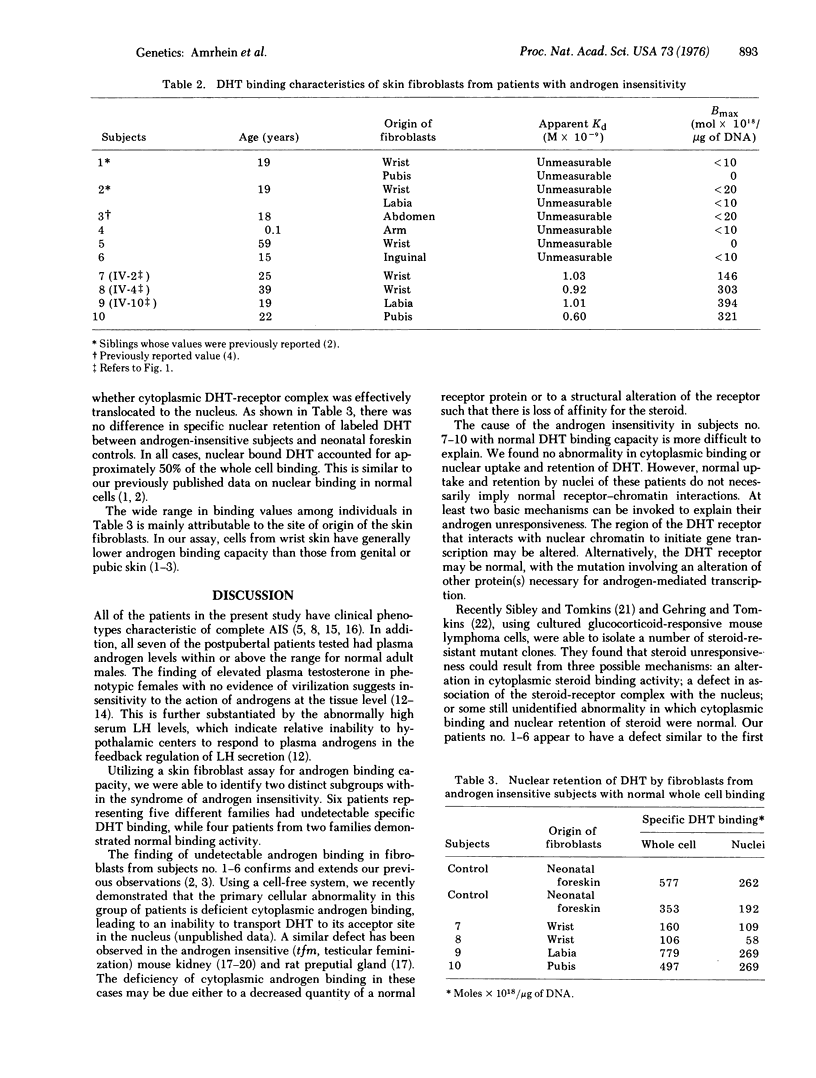Abstract
We have studied ten phenotypically similar patients with complete androgen insensitivity. All of the patients tested had significantly elevated serum luteinizing hormone and plasma androgens within or above the normal adult male range. On the basis of specific dihydrotestosterone binding by skin fibroblasts, we identified two subgroups. Six patients from five different families had undetectable dihydrotestosterone binding, while four patients from two families had normal binding activity. Our results indicate that within the clinical syndrome of androgen insensitivity there are at least two distinct genetic variants. These variants may result from allelic mutations of the same X-linked gene specifying the dihydrotestosterone receptor or, alternatively, from mutations of separate genes both being essential for androgen action in responsive cells.
Full text
PDF



Selected References
These references are in PubMed. This may not be the complete list of references from this article.
- Attardi B., Ono S. Cytosol androgen receptor from kidney of normal and testicular feminized (Tfm) mice. Cell. 1974 Aug;2(4):205–212. doi: 10.1016/0092-8674(74)90012-9. [DOI] [PubMed] [Google Scholar]
- BURTON K. A study of the conditions and mechanism of the diphenylamine reaction for the colorimetric estimation of deoxyribonucleic acid. Biochem J. 1956 Feb;62(2):315–323. doi: 10.1042/bj0620315. [DOI] [PMC free article] [PubMed] [Google Scholar]
- Bardin C. W., Bullock L. P., Sherins R. J., Mowszowicz I., Blackburn W. R. Androgen metabolism and mechanism of action in male pseudohermaphroditism: a study of testicular feminization. Recent Prog Horm Res. 1973;29:65–109. doi: 10.1016/b978-0-12-571129-6.50006-3. [DOI] [PubMed] [Google Scholar]
- Gehring U., Tomkins G. M. A new mechanism for steroid unresponsiveness: loss of nuclear binding activity of a steroid hormone receptor. Cell. 1974 Nov;3(3):301–306. doi: 10.1016/0092-8674(74)90145-7. [DOI] [PubMed] [Google Scholar]
- Gehring U., Tomkins G. M. Characterization of a hormone receptor defect in the androgen-insensitivity mutant. Cell. 1974 Sep;3(1):59–64. doi: 10.1016/0092-8674(74)90040-3. [DOI] [PubMed] [Google Scholar]
- Gehring U., Tomkins G. M., Ohno S. Effect of the androgen-insensitivity mutation on a cytoplasmic receptor for dihydrotestosterone. Nat New Biol. 1971 Jul 28;232(30):106–107. doi: 10.1038/newbio232106a0. [DOI] [PubMed] [Google Scholar]
- Keenan B. S., Meyer W. J., 3rd, Hadjian A. J., Jones H. W., Migeon C. J. Syndrome of androgen insensitivity in man: absence of 5 alpha-dihydrotestosterone binding protein in skin fibroblasts. J Clin Endocrinol Metab. 1974 Jun;38(6):1143–1146. doi: 10.1210/jcem-38-6-1143. [DOI] [PubMed] [Google Scholar]
- Keenan B. S., Meyer W. J., Hadjian A. J., Migeon C. J. Androgen receptor in human skin fibroblasts. Characterization of a specific 17beta-hydroxy-5alpha-androstan-3-one-protein complex in cell sonicates and nuclei. Steroids. 1975 Apr;25(4):535–552. doi: 10.1016/0039-128x(75)90030-6. [DOI] [PubMed] [Google Scholar]
- LOWRY O. H., ROSEBROUGH N. J., FARR A. L., RANDALL R. J. Protein measurement with the Folin phenol reagent. J Biol Chem. 1951 Nov;193(1):265–275. [PubMed] [Google Scholar]
- MORRIS J. M., MAHESH V. B. FURTHER OBSERVATIONS ON THE SYNDROME, "TESTICULAR FEMINIZATION". Am J Obstet Gynecol. 1963 Nov 15;87:731–748. [PubMed] [Google Scholar]
- MORRIS J. M. The syndrome of testicular feminization in male pseudohermaphrodites. Am J Obstet Gynecol. 1953 Jun;65(6):1192–1211. doi: 10.1016/0002-9378(53)90359-7. [DOI] [PubMed] [Google Scholar]
- Meyer W. J., 3rd, Migeon B. R., Migeon C. J. Locus on human X chromosome for dihydrotestosterone receptor and androgen insensitivity. Proc Natl Acad Sci U S A. 1975 Apr;72(4):1469–1472. doi: 10.1073/pnas.72.4.1469. [DOI] [PMC free article] [PubMed] [Google Scholar]
- Rivarola M. A., Migeon C. J. Determination of testosterone and androst-4-ene-3, 17-dione concentration in human plasma. Steroids. 1966 Feb;7(2):103–117. doi: 10.1016/0039-128x(66)90019-5. [DOI] [PubMed] [Google Scholar]
- Rivarola M. A., Saez J. M., Meyer W. J., Kenny F. M., Migeon C. J. Studies of androgens in the syndrome of male pseudohermaphroditism with testicular feminization. J Clin Endocrinol Metab. 1967 Mar;27(3):371–378. doi: 10.1210/jcem-27-3-371. [DOI] [PubMed] [Google Scholar]
- Sibley C. H., Tomkins G. M. Mechanisms of steroid resistance. Cell. 1974 Aug;2(4):221–227. doi: 10.1016/0092-8674(74)90014-2. [DOI] [PubMed] [Google Scholar]
- Tremblay R. R., Beitins I. Z., Kowarski A., Migeon C. J. Measurement of plasma dihydrotestosterone by competitive protein-binding analysis. Steroids. 1970 Jul;16(1):29–40. doi: 10.1016/s0039-128x(70)80093-9. [DOI] [PubMed] [Google Scholar]
- Tremblay R. R., Foley T. P., Jr, Corvol P., Park I. J., Kowarski A., Blizzard R. M., Jones H. W., Jr, Migeon C. J. Plasma concentration of testosterone, dihydrotestosterone, testosterone-oestradiol binding globulin, and pituitary gonadotrophins in the syndrome of male pseudo-hermaphroditism with testicular feminization. Acta Endocrinol (Copenh) 1972 Jun;70(2):331–341. doi: 10.1530/acta.0.0700331. [DOI] [PubMed] [Google Scholar]
- Tremblay R. R., Kowarski A., Park I. J., Migeon C. J. Blood production rate of dihydrotestosterone in the syndrome of male pseudohermaphroditism with testicular feminization. J Clin Endocrinol Metab. 1972 Jul;35(1):101–107. doi: 10.1210/jcem-35-1-101. [DOI] [PubMed] [Google Scholar]


